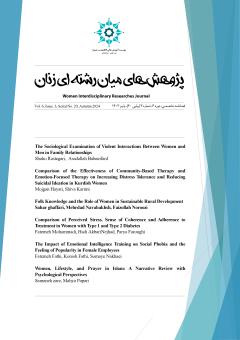Comparison of Perceived Stress, Sense of Coherence and Adherence to Treatment in Women with Type 1 and Type 2 Diabetes
Subject Areas :
fatemeh mohammadi
1
![]() ,
hadi AkbariNejhad
2
,
hadi AkbariNejhad
2
![]() ,
parya faroughi
3
,
parya faroughi
3
1 - M.A. Student of Psychology, Nabi Akram Higher Education Institute, Tabriz, Iran.
2 - Assistant Professor, Department of Psychology, Nabi Akram Higher Education Institute, Tabriz, Iran.
3 - Assistant Professor, Department of Psychology, Nabi Akram Higher Education Institute, Tabriz, Iran.
Keywords: Perceived Stress, Sense of Coherence, Adherence to Treatment, Type 1 and Type 2 Diabetes.,
Abstract :
The aim of this study was to compare perceived stress, sense of coherence and adherence to treatment in patients with type 1 and type 2 diabetes. The research method was causal-comparative. The statistical population consisted of all patients with type 1 and type 2 diabetes in Tabriz city in 2023 (1402 in Shamsi Calendar) who were members of the diabetes association of this city. The statistical sample included 100 patients with type 1 and type 2 diabetes, 50 women with type 1 diabetes and 50 women with type 2 diabetes. Participants were selected using a purposeful sampling method, and the data were collected using Cohen's Perceived Stress Scale (1983), Felsenberg's Sense of Coherence Scale (2006), and Madanlo's Adherence to Treatment Questionnaire for Chronic Diseases (2013). To analyze the data, the multivariate analysis of variance (MANOVA) test was used. The analysis of the research hypotheses indicated that here was no significant difference between patients with type 1 and type 2 diabetes in terms of perceived stress and its components (perceived self-efficacy and perceived helplessness) (P>0.05), sense of coherence and its components (comprehensibility [ability to understand], management ability and meaningfulness) (P>0.05) and adherence to treatment and its components (interest in treatment, willingness to participate in treatment, ability to adapt, integration of treatment with life, adherence to treatment, commitment to treatment and hesitation in implementation treatment) (P>0.05). According to the obtained results, it can be said that the amount of perceived stress, sense of coherence and adherence to treatment is the same in both groups of patients with type 1 and type 2 diabetes.
